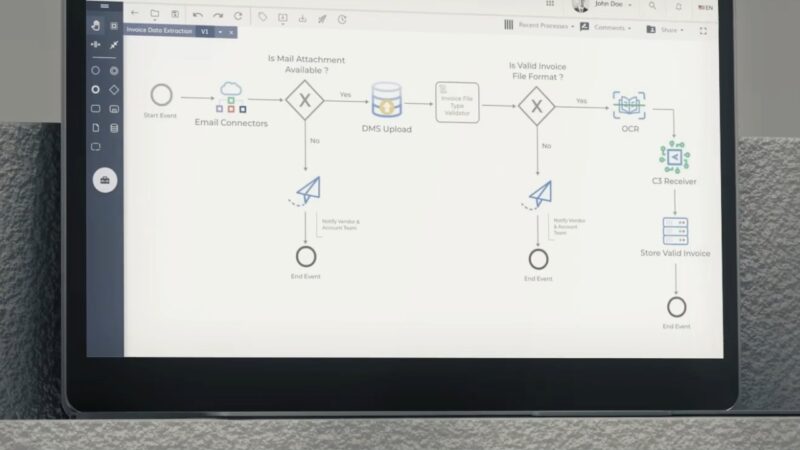Low-code platforms revolutionize how businesses develop applications by removing the need for extensive coding. Companies can build and deploy solutions rapidly, responding to changes more effectively.
AI integration enhances these platforms further, automating repetitive tasks and improving workflows. The combination of low code and AI enables faster innovation, scaling, and streamlined operations, offering businesses a flexible and efficient way to manage digital transformation.
Table of Contents
ToggleLow-Code Platforms Revolutionize Development

Low-code platforms have transformed the landscape of application development by making it faster, simpler, and more accessible to non-technical users.
As a result, companies can quickly adapt to market demands and improve operational efficiency without relying on a full team of developers.
Main Benefits
- Speed of Development: Traditional software development can take months, but low-code platforms drastically cut this time by providing ready-made components that can be quickly configured to meet business needs.
- Ease of Use: These platforms empower non-technical users to participate in app creation, reducing the burden on IT teams. By democratizing development, organizations can respond faster to internal and external demands.
- Cost Reduction: Low-code solutions minimize the need for large development teams, saving significant IT expenses. As fewer specialized developers are required, organizations can allocate resources to other areas of their operations.
- Customization and Scalability: Though these platforms simplify development, they remain highly customizable. Companies can scale their applications as their needs grow, ensuring long-term usability.
Key Features
Visual Development Tools
Such tools are accessible to everyone, making it easy to design, integrate, and deploy applications without heavy coding.
Pre-Built Components
Low-code platforms offer pre-built templates and components, allowing businesses to rapidly configure solutions that meet their specific needs.
Seamless Integration
Most low-code platforms come equipped with the ability to integrate easily with other systems.
Automation and Efficiency
Automation is a crucial feature of low-code platforms. They help automate repetitive business processes, such as data entry, task management, and workflow approval.
Subtle Integration of Advanced Tools
For example, organizations looking to improve connectivity and streamline workflows often use solutions like Jitterbit, which seamlessly integrates with low-code platforms to enhance application development.
Speed and Flexibility in Transformation

Low-code platforms cut down the time needed for application development. Instead of lengthy coding processes, businesses can create and deploy applications rapidly, adapting to changing needs in real-time.
- Faster Development: Applications are built in weeks, not months, using pre-configured components and visual tools.
- Adaptable Solutions: Changes and updates can be made quickly without disrupting operations.
- Minimal Technical Barriers: Even non-technical staff can contribute to app creation, easing the workload on IT teams.
Reducing IT Costs and Developer Dependency
Businesses can cut down on IT expenses while speeding up the development process.
- Lower Labor Costs: Non-developers can build apps, reducing the need for expensive IT resources.
- Faster Time to Market: Applications get built and deployed faster, avoiding long-term project costs.
- Maintenance Efficiency: Simplified systems mean less time and money spent on maintenance and updates.
AI Integration Enhances Efficiency

AI automates routine tasks and optimizes workflows, allowing for faster and more accurate application development. It assists users in making smarter decisions.
How AI Improves Low-Code Platforms?
- Automation: AI streamlines repetitive tasks like data entry, freeing up time for more complex work.
- Error Reduction: Automated testing and real-time feedback help prevent mistakes during app development.
- Enhanced Workflow: AI optimizes processes, ensuring applications run more efficiently and can adapt to changing demands.
Automating Workflows for Faster Innovation
Automating workflows improves operational efficiency and reduces errors, making it easier for companies to innovate and scale.
Advantages of Workflow Automation
- Increased Productivity: Automation handles routine tasks, freeing up employees for more complex projects.
- Error Elimination: With automated checks and balances, the margin for human error is greatly reduced.
- Cost Efficiency: Less time spent on manual processes leads to significant cost savings.
Scaling with Automation
Low-code platforms not only help automate workflows but also make scaling easier. As business needs grow, these platforms enable companies to adjust processes and applications with minimal disruption.
Scaling Solutions Combined With AI

With AI integrated into low-code solutions, scalability is further enhanced, automating processes and ensuring that applications can handle increased demand without disruption.
Seamless Scaling
Low-code platforms are built with flexibility in mind.
- Modular Infrastructure: Applications are constructed using reusable components, making it easy to expand functionalities or add new features without overhauling the entire system.
- Cloud Integration: Many low-code platforms support cloud-based deployment, which allows businesses to scale seamlessly without worrying about physical infrastructure. This ensures that as user demand increases, the system can automatically adjust to handle the load.
- Cross-Platform Support: Low-code tools ensure compatibility across various devices and platforms, so applications can be used universally without needing multiple versions or major modifications.
Role of AI in Enhancing Scalability
AI plays a critical role in ensuring that low-code applications can scale intelligently.
- Predictive Analytics: AI tools analyze usage data to predict future needs, enabling businesses to scale applications before performance issues arise.
- Automated Resource Management: AI helps monitor and allocate system resources, ensuring that applications remain fast and efficient as they grow. This automated scaling reduces downtime and the need for manual adjustments.
- Process Optimization: AI can also identify inefficiencies in workflows and recommend or implement optimizations, ensuring that as the application scales, it continues to operate smoothly and cost-effectively.
For instance, enterprises like PepsiCo and Sprint have adopted low-code platforms to build applications that support global operations.
Streamlining Operations

Low-code platforms play a crucial role in streamlining operations across businesses. By simplifying the development of applications, automating tasks, and integrating with existing systems.
- Automation of Routine Tasks: Low-code platforms help automate repetitive tasks like data entry, reporting, and approval workflows. This automation reduces human error and saves time, enabling employees to focus on higher-value activities.
- Centralized Control: Businesses can manage operations more effectively by integrating various applications into a single low-code platform. This centralized control ensures that data flows smoothly across different departments, improving decision-making and operational visibility.
- Process Standardization: With pre-configured templates and workflows, low-code platforms ensure consistent processes across departments, improving efficiency and reducing the time spent managing operational discrepancies.
For example, financial institutions have used low code to automate compliance processes, while healthcare organizations have implemented it to improve patient management systems.
FAQs
Summary
Low-code platforms offer businesses an effective way to streamline operations, reduce costs, and speed up development without needing deep technical expertise. They allow rapid application building, reduce reliance on specialized developers, and scale as business needs grow.
AI integration within these platforms further enhances efficiency, automating workflows and optimizing processes to handle even the most complex applications.
Related Posts:
- Why the Digital Revolution is Changing How We Enjoy…
- How to Earn Some Money on the Side Through…
- 10 Creative Ways to Say "Thank You for Your Order"…
- Restaurants That Accept EBT Food Stamps Near Me:…
- Instant Pot Settings & Buttons Explained: Your Guide…
- How to Check Body Temperature with Phone: Your Guide…















